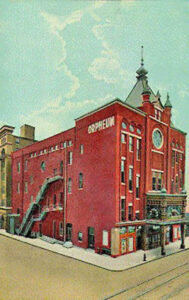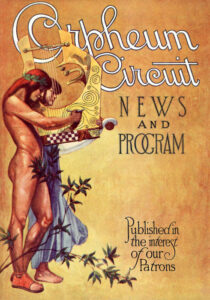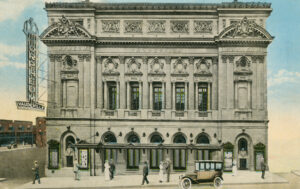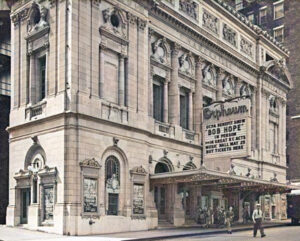In Kansas City, Missouri’s history, there were two Orpheum Theatres.
The first Orpheum Theatre was located at West 9th Street and May Street. The building initially housed H.D. Clark’s 9th Street Theatre, containing 1,998 seats. It was leased by the Orpheum Theatre and Realty Company in 1898.
The Orpheum Circuit was a chain of vaudeville theaters founded in 1886 by vaudeville impresario Gustav Walter, who opened the Orpheum Opera House in San Francisco, California, in June 1887. Presenting a higher type of entertainment than burlesque and variety houses, it quickly became one of the most popular theaters in San Francisco, attracting a wide variety of people. Later Walter took on business partner Morris Meyerfeld who managed the business and financial aspects of the Orpheum, while Walter managed the talent and booking for the theater.
In 1894, the pair leased the Grand Opera House in Los Angeles and opened a second Orpheum Theatre, which sold out on the first day. Programs offered at the Orpheum Theaters varied in length from seven to fifteen acts, with a nine-act bill being the average. The show opened with acrobats, jugglers, dancers, or animal acts, followed by a talented singing team or repartee. Other acts included humorous playlets, comedians, singing and dancing spectacles, amusing speakers, musicians, and a famous headliner, the star.
Walter and Meyerfeld continued expanding their operations by opening more theaters between the Midwestern United States and Pacific Coast theaters. Due to its railroad connections and thriving economy, Kansas City, Missouri, was chosen as its next location.
Martin Lehman opened the Orpheum Theatre in Kansas City on February 6, 1898, with a bill that attempted to prove that vaudeville was a higher class than variety shows. It opened to a sold-out house.
“The Orpheum Theatre is now generally known as a gold mine and expects to break all records this year.”
— Kansas City Journal-Post, 1904
The Orpheum Theatre continued to operate on 9th Street until 1914, when a new $500,000 Orpheum Theatre was completed at 1212 Baltimore, just south of the Muehlebach Hotel. Built to resemble the Paris Opera House, the new Orpheum Theatre was designed for a luxurious experience. The exterior was faced with terra cotta, and along the top of the building’s façade were carved panels symbolically depicting art and music.
The vaulted lobby floor was enhanced with terra cotta and marble mosaics in figured patterns and panels. A spacious ladies’ lounge provided divans, lounging chairs, writing desks, telephones, and dressing tables, and offered maid service. Silk draperies and French carpets added to the luxury. The 2,220-seat auditorium included a 40-foot domed roof painted blue and highlighted with artificial stars. The mahogany seats were upholstered in leather. There were 22 artists’ dressing rooms and a spacious orchestra room directly under their pit.
It opened to a packed house on December 26, 1914, and became a favorite spot for Kansas Citians. Prices ranged from 10 cents for the top balcony to 75 cents for box seats. The stately Neo-classical venue drew an exclusive crowd of civic, business, and cultural leaders. The prestigious Kansas City Club reserved the entire sixth row for its members every season.
In the meantime, the old Orpheum Theatre stood empty, neglected, and vandalized for years before it was razed in 1922 by its owners, the H.D. Clark estate.
During the 1890-1930 vaudeville heydays, female impersonators enjoyed impressive, successful careers and became household names nationwide. Even during the 1920s, after Prohibition began, the tradition expanded into nightclubs and cabarets, drawing enormous crowds in large cities like New York and Chicago. Later, American entertainment tastes became more conservative. Repressive oversight of liquor consumption followed Prohibition’s 1933 repeal, and female impersonation disappeared from “legitimate” and cabaret stages throughout the United States. However, female impersonators characterized Kansas City’s booming economy until the late 1930s.
For 27 years, Orpheum Vaudeville was presented in Kansas City with stars such as Will Rogers, Al Jolson, Eddie Cantor, Fred Stone, Elsie Janis, Nora Bayes, Willie and Eugene Howard, and Sarah Bernhardt.
After its vaudeville days, the Orpheum Theater housed legitimate theater in the 1930s and motion pictures in the 1940s. In 1948 it was taken over by Fox Midwest Theatres. It was closed on November 2, 1955, with Clark Gable starring in The Tall Men. It was purchased from Fox Midwest in January 1956 by the Trianon Hotel Company, operator of the adjacent Muehlebach Hotel. The theater was razed in 1961, and the Muehlebach Convention Center took its place.
©Kathy Alexander/Legends of America, updated March 2024.
Also See:
Sources:
Cinema Treasures – 1
Cinema Treasures – 2
Kansas City Public Library
Pendergast Years
Wikipedia




